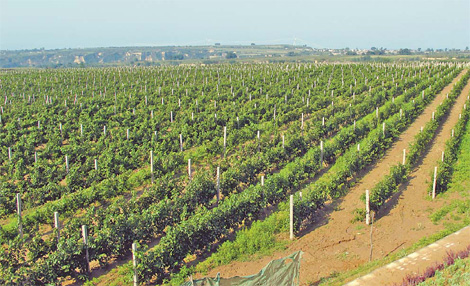Life and Leisure
Grapes of loess
By Ye Jun (China Daily)
Updated: 2010-09-27 16:13
 |
Large Medium Small |
|
Rongzi winery, located in southwestern Shanxi province, has good terroir for growing grapes. [Photos by Ye Jun/China Daily] |
A coal miner secures the aid of influential French winemaker Jean-claude Berrouet to help realize his ambitious plans. Ye Jun reports
Being a coalmine owner and a winery owner would seem to be distinctly different occupations. But Zhang Wenquan, a Shanxi entrepreneur, is both. The head of Shanxi's Yong Chang Yuan Group, Zhang owns a coal company with more than 3,000 employees, with assets of 700 million yuan ($104 million) as well as Rongzi winery. Zhang recently announced its cooperation with Jean-claude Berrouet, who retired as the chief winemaker with the renowned Chateau Petrus in France at the end of the 2007 vintage.
"Wine tells the story of the soil, and a winery tells the story of a country," says Berrouet, who has already visited the winery and says that it has a good terroir (refers to the combination of factors that gives personality to a wine) for growing grapes.
Rongzi is named after the mother of Jin Wen Gong, king of the Kingdom of Jin, located in what is now Shanxi province, 2,700 years ago. According to Zhang, a local legend says Rongzi was one of the first in Chinese history to brew wine.
|
Zhang Wenquan, owner of Rongzi winery. |
Wang Qi, general secretary with the China Alcoholic Drinks Industry Association, says it is common for Chinese wine companies to hire foreign experts. Changyu and Dynasty both hired foreign winemakers.
"But it shows great foresight for a private Chinese company to hire such a renowned winemaker," he says.
"My goal is to establish a winery in Chinese style, producing a high quality, Chinese chateau wine," Zhang says.
The company has invested more than 200 million yuan in Rongzi, which is located southwest of Shanxi, near the Yellow River and is built in the Chinese Song Dynasty (960-1279) style, with the wine cellars built inside the province's unique loess caves.
Zhang says that the loess will give the wine a distinctive character, because the wind-blown deposits of silt are low in phosphorous and high in calcium and organic matter.
The vineyards are 900-1,100 meters above sea level and there is a sharp temperature difference between day and night and the average annual rainfall is 570 mm, which means a long growth time, resulting in sweet grapes.
The winery will be the second winery in China to use a nitrogen anti-oxidation technique and the company has imported top-level wine producing equipment.
The winery started to plant grapes in 2007 in eight villages in Changning township, Xiangning county of Linfen city in Shanxi. At present, there are 211 hectares of vineyards, which Zhang aims to increase to 667 hectares.
He says he hopes that he will be able to increase wine production up to five times in 10-20 years, and he intends to have his wine on the market in 2012.
Zhang's plan also includes organic planting, as well as developing tourist facilities around the winery, which is close to the Yellow River Hukou Falls.
|
Zhang Wenquan and Jean-claude Berrouet at the ceremony in Taiyuan, Shanxi province, announcing their cooperation. |


